Engineering Freshmen Tackle Real-World Testing Projects
Students entering college today are accustomed to commercial software that vibrates with color and action. Small wonder, then, that when the students write a computer program for class, they are woefully disappointed with the primitive—and unromantic—paper output that results.
Professors at Northeastern University in Boston have found a unique way to combine the romance of discovery and experimentation with the precision of basic computer programming: a discovery-based lab that uses test and measurement-based applications to help freshmen learn basic skills in subsurface imaging for use with a range of real-world problems.
The Problem
Freshmen bring diverse computing backgrounds, abilities, and interests to the classroom. Some have designed Web pages and completed courses in C or C++, while others possess only a rudimentary knowledge of directory structures and file manipulation. Moreover, it is not uncommon to find freshmen who aspire to become computer scientists in the same class with civil-engineering students who have less desire to learn about computer algorithms and program structures.
So how does a professor design a course and present applications that stimulate and challenge the less interested students without boring those who have a passion for computers?
The answer, you might think, would be to divide the groups according to interest and experience. But this leaves unsolved the more fundamental problem of finding teaching applications that are both engaging and within the students’ scope.
In either case, the course is unsatisfactory for all concerned—a less than ideal introduction to the engineering profession at a time when many students already are making important decisions about their sophomore year. According to National Science Foundation statistics, that decision is likely to be a negative one. Engineering student enrollments have been falling nationwide for more than 10 years, and the dropout rate by the sophomore year is 40%.
Enter: The Discovery Lab
Professors Stephen McKnight and Michael Silevitch of Northeastern University conceived the idea of the discovery lab while working on the education component of a National Science Foundation proposal for an Engineering Research Center in Subsurface Sensing and Imaging Systems (CenSSIS).
This $16.2 million, multiinstitutional, interdisciplinary center is headquartered at Northeastern’s College of Engineering. It includes Boston University, Rensselaer Polytechnic Institute (RPI), and the University of Puerto Rico as academic partners and Massachusetts General and Brigham and Women’s Hospitals, Lawrence Livermore National Laboratory, and the Woods Hole Oceanographic Institution as strategic affiliates.
CenSSIS was founded on the premise that many subsurface problems, from cancer lesions and underground pollution to failing bridges and cardiac plaque, can be detected using essentially the same process. While each problem involves a different sensing modality (acoustics, electromagnetic induction, ground-penetrating radar, ultrasound, magnetic resonance, optical, or X-ray), they all seek to infer internal structure from complex and distorted signals outside the obscuring volume and often use related computational and algorithmic methods.
The goal of CenSSIS is to create a unified discipline that will use advanced technology to solve geophysical, medical, forensic, and other problems involving subsurface sensing. The educational component focuses on curriculum development from high school through post-graduate study. At its core is what Mr. McKnight and Mr. Silevitch call a high-tech tools and toy laboratory (HTT&TL) that combines computers with test and measurement instrumentation to teach computer programming and engineering concepts through real-time data acquisition and control.
The HTT&TL can be used to benchmark, interface with, and characterize state-of-the-art commercial subsystems such as global positioning systems sensors, ground-penetrating radar, digital cameras, and hard disk arrays. Students measure the performance of subsystems assembled from top-of-the-line components and then watch as a computer instruction results in a physical movement. The hands-on experience is inspiring, and the sequential steps are easily observed.
The HTT&TL can be adapted to meet specific curriculum requirements, leveraging the resources and expertise at each participating institution. For example, the HTT&TL at Northeastern’s College of Engineering, whose strength lies in electromagnetics, signal processing, and database structures, is based on ultrasonic transducers and positioners. The HTT&TL at Boston University addresses optical imaging systems, while RPI focuses on networks, image processing, and inverse methods.
Lab Setup
At Northeastern, the HTT&TL was implemented with the assistance of Professor Carr Everbach, an acoustics expert from Swarthmore College, and Professor Gilead Tadmor, a classroom instructor and control systems theorist. Students used ultrasonic transducers and positioners to determine the velocity of sound in air and create images of objects by their reflection.
Each student workstation at the HTT&TL is equipped with an Agilent Technologies programmable multimeter (34401A), a power supply (E632A), a signal generator (33120A), and a digital oscilloscope (54645A) linked over a bus to a GPIB controller card in the backplane of a standard Pentium II PC. Also included are a National Instruments’ 6024E Multifunction I/O Board in the computer backplane and the breakout boxes for the input/output connections. These instruments provide the basis for controlling the experiments and performing data acquisition.
Mr. McKnight chose the MATLAB® technical computing environment as the software platform for the HTT&TL. MATLAB is a high-level programming language that lets students express problems, analyze and visualize data, test ideas, and explore alternatives easily. The lab also uses the MATLAB-based data acquisition and instrument control toolboxes for interfacing with the test instrumentation.
Teaching With High-Tech Tools and Toys
Mr. McKnight and his colleagues have implemented the Northeastern discovery lab in Engineering Problem-Solving Using Software Applications, a general engineering course for freshmen. The course is designed to teach computer problem-solving skills and basic engineering concepts. It also introduces MATLAB and Excel, tools used in all four engineering departments at Northeastern.
The course consists of seven, 140-minute lab modules presented in a 10-week quarter. Labs 3, 6, and 7 are allocated two weeks each. Each section is limited to 20 students, with two students working at each experimental station. The modules are designed to minimize work out-side the lab and provide cumulative learning. Programming skills and lessons learned in one module are confirmed and built upon in the following module.
In the first lab, students control the oscilloscope manually and use a pair of ultrasonic transducers to determine the speed of sound in air using an Excel spreadsheet. They observe real acoustic effects, including interference, reflection, diffraction, and antenna patterns. Lab 2 introduces MATLAB and demonstrates the control of a stepper motor. Students learn the concept of feedback, sequential programming steps, and conditional looping.
Lab 3 repeats the material of Lab 1, except that the students now use MATLAB to record the receiver signal, measure the time delay, and perform the linear regression to find the velocity of sound in air. Over two sessions, the students observe the trade-off speed and accuracy for different sampling rates and, after some simple signal preconditioning, learn to select threshold test criteria using MATLAB conditional logic. In Lab 4, the students control a travel X-Y positioner mounted on an aquarium tank and write a program to create a raster scan in preparation for Labs 5, 6, and 7, which are all imaging labs.
In Lab 5, the students use an ultrasound transducer in water instead of in air to recreate the measurements derived in Lab 3. They also experiment with partial transmission through films and objects in preparation for the subsurface imaging experiment in Lab 7.
In Lab 6, the students learn to image an object by reflection. The ultrasonic transducer now is raster-scanned with the X-Y positioner, and the time delay of a pulse reflected from an object on the aquarium wall is plotted as distance vs. position.
In Lab 7, the students learn about subsurface imaging. They are given an opaque gelatin package with a metal shape inside it. They submerge the package in the aquarium tank and image it with the ultrasonic transducer, as in Lab 6. But by this point in the course, by careful thresholding or time-gating, the students can image the subsurface metal rather than the front surface of the package.
Student Benefits
The computer engineering course introduces students to real-time data acquisition and control. According to instructors at Northeastern, HTT&TL and MATLAB make an excellent introduction to programming concepts that often are troublesome in the freshman year and are ideal tools for educating the engineers and scientists of tomorrow. Real-world laboratory effects, such as noise, sampling artifacts, and thresholding techniques, are experienced in ways that usually are not available in freshman science labs.
Students practice reconciling real data with theory and infer simple mathematical models from measurement data. They also are exposed to some of the excitement of engineering and asked to think like engineers, making realistic engineering trade-offs between experimental accuracy and measurement time and learning the vital but difficult lesson that good enough often is preferable to perfect.
References
- McKnight, S.W., et al., “Teaching Computing to Engineering Freshmen Through a ‘High-Tech Tools and Toys Laboratory,’” ASEE Proceedings, Multimedia Session 2793, 2001.
-
Silevitch, M.B. and Saleh B.E.A., Executive Summary of “An Engineering Research Center for Subsurface Sensing and Imaging Systems (CenSSIS): A Proposal to the National Science Foundation,” 1999.
Acknowledgments
The HTT&TL at Northeastern University was supported in part by CenSSIS, the Center for Subsurface Sensing and Imaging Systems, under the Engineering Research Centers Program of the National Science Foundation.
The authors thank Mr. McKnight, associate professor of electrical and computer engineering at Northeastern University, who heads the CenSSIS’s educational initiative. All figures are courtesy of Northeastern University College of Engineering. For more information on the CenSSIS at Northeastern University, visit www.censsis.neu.edu/.
About the Author
Mary Beth McDonald earned a B.S. in technical communications from Northeastern University. She has been writing and editing for The MathWorks since 1996.
Rosemary Oxenford is a senior writer-editor at The MathWorks. She holds a Ph.D. from Harvard University.
The MathWorks, 3 Apple Hill Dr., Natick, MA 01760, 508-647-7000.
Return to EE Home Page
Published by EE-Evaluation Engineering
All contents © 2001 Nelson Publishing Inc.
No reprint, distribution, or reuse in any medium is permitted
without the express written consent of the publisher.
July 2001


